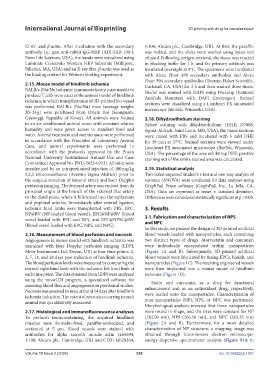Page 344 - IJB-10-2
P. 344
International Journal of Bioprinting 3D printing with drug for vascular repair
Ki-67, and β-actin. After incubation with the secondary 1:100; Abcam plc., Cambridge, UK). At first, the paraffin
antibody, i.e., goat anti-rabbit IgG-HRP (ADI-SAB-100-J, was melted, and the slides were washed using xylan and
Enzo Life Sciences, USA), the bands were visualized using ethanol. Following antigen retrieval, the tissue was reacted
Luminate Crescendo Western HRP Substrate (Millipore, in blocking buffer for 1 h, and the primary antibody was
Billerica, MA, USA) and an X-ray film. β-actin was used as incubated overnight at 4°C. The specimens were incubated
the loading control for Western blotting experiment. with Alexa Fluor 488 secondary antibodies and Alexa
Fluor 594 secondary antibodies (Thermo Fisher Scientific,
2.15. Mouse model of hindlimb ischemia Carlsbad, CA, USA) for 2 h and then washed three times.
BALB/c (Nu/Nu) athymic immunodeficient mice unable to Nuclei was stained with DAPI using ProLong Diamond
produce T cells were used as the animal model of hindlimb Antifade Mountant with DAPI (Invitrogen). Stained
ischemia in which transplantation of 3D-printed bio-vessel sections were visualized using a Lionheart FX automated
was performed. BALB/c (Nu/Nu) mice (average weight: microscope (BioTek, Winooski, USA).
20–24 g) were purchased from Orient Bio (Seongnam,
Gyeonggi, Republic of Korea). All animals were housed 2.18. Dihydroethidium staining
in an air-conditioned animal room with constant relative Before staining with dihydroethidium (DHE; D7008,
humidity and were given access to standard food and Sigma-Aldrich, Saint Louis, MO, USA), the tissue sections
water. Animal treatment and maintenance were performed were rinsed with PBS and incubated with 5 mM DHE
in accordance with the Principles of Laboratory Animal for 30 min at 37°C. Stained sections were viewed under
Care, and animal experiments were performed in Lionheart FX automated microscope (BioTek, Winooski,
accordance with the protocols approved by the Pusan USA). The percentage of the area exhibiting DHE-positive
National University Institutional Animal Use and Care staining out of the entire stained area was calculated.
Committee (Approval No. PNU-2022-0212). All mice were
anesthetized by an intraperitoneal injection of 400 mg/kg 2.19. Statistical analysis
2,2,2 tribromoethanol (Avertin; Sigma-Aldrich) prior to Two-tailed unpaired Student’s t-test and one-way analysis of
the surgical resection of femoral artery and laser Doppler variance (ANOVA) were conducted for data analyses using
perfusion imaging. The femoral artery was excised from its GraphPad Prism software (GraphPad, Inc., La Jolla, CA,
proximal origin at the branch of the external iliac artery USA). Data are expressed as mean ± standard deviation.
to the distal point, where it bifurcated into the saphenous Differences were considered statistically significant at p < 0.05.
and popliteal arteries. Immediately after arterial ligation,
ischemic hind limbs were transplanted with PBS, EPC, 3. Results
NP@BV (NP-loaded blood vessel), EPC@NP@BV (blood 3.1. Fabrication and characterization of NPS
vessel loaded with EPC and NP), and EPC@NPSC@BV
(blood vessel loaded with EPC, NPS, and NPC). and NPC
In this study, we present the design of 3D-printed artificial
2.16. Measurement of blood perfusion and necrosis blood vessels loaded with nanoparticles, each containing
Angiogenesis in mouse model with hindlimb ischemia was two distinct types of drugs. Atorvastatin and curcumin
examined with laser Doppler perfusion imaging (LDPI; were individually encapsulated within nanoparticles
Moor Instruments Ltd, Devon, UK) at four time points: 0, (Figure 1A and B). Subsequently, 3D-printed artificial
3, 7, 14, and 28 days post-induction of hindlimb ischemia. blood vessels were fabricated by fusing EPCs, bioink, and
The blood perfusion levels were measured by comparing the nanoparticles (Figure 1C). The resulting engineered vessels
normal right hind limb with the ischemic left hind limb at were then implanted into a mouse model of hindlimb
each time point. The data obtained from LDPI were analyzed ischemia (Figure 1D).
using the moorLDI program, a specialized software for Statin and curcumin, as a drug for functional
assessing blood flow and angiogenesis in preclinical studies. enhancement and as an antioxidant drug, respectively,
Necrosis was assessed in mice at 0 and 14 days after hindlimb were loaded onto the nanoparticles. Characterization of
ischemia induction. The extent of necrosis occurring in each
animal was quantitatively measured. pure nanoparticles (NP), NPS, or NPC was performed.
Morphological analysis revealed that these nanoparticles
2.17. Histological and immunofluorescence analyses were round in shape, and the sizes were constant for NP
To perform immunostaining, the acquired hindlimb (282.09 nm), NPS (266.56 nm), and NPC (283.25 nm)
muscles were formalin-fixed, paraffin-embedded, and (Figure 2A and B). Furthermore, for a more detailed
sectioned at 5 μm. Blood vessels were stained with characterization of NP structure, a mapping image was
antibodies for alpha smooth muscle actin (ab5694, obtained through transmission electron microscope-
1:100; Abcam plc., Cambridge, UK) and CD31 (ab28364, energy dispersive spectrometer analysis (Figure S1A in
Volume 10 Issue 2 (2024) 336 doi: 10.36922/ijb.1857

